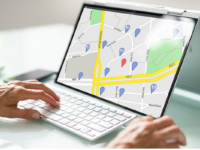Visitation data, often referred to as ‘people movement data’, plays a pivotal role in understanding the movements and behaviours of visitors within a specific location. It provides insights into the locations or points of interest (POI) frequented by shoppers before and after visiting a particular establishment.
This data is not merely informative, but indispensable for making informed decisions concerning network planning, business expansion, and understanding customer demographics.
By analysing visitation data alongside other geographical information, businesses can identify optimal growth locations, ensuring proximity to relevant POI and accessibility to target audiences. Using these insights aids sales and marketing teams in strategising promotions, experiential pop-ups, and agent networks, thereby enhancing overall market planning.
So what exactly is visitation data?
Visitation data offers highly detailed insights into people’s movements, intentions, motivations, and behaviours. It sheds light on visitation patterns, frequency of visits, consumer profiles, and more.
Understanding the trip patterns, where people live, work, shop, recreate, and travel is fundamental to comprehending what drives individuals to specific locations.
Here, we outline four ways in which visitation data can help franchisors with location-based decisions.
1. Deepening customer understanding
Retaining existing customers is cost-effective, and visitation data provides invaluable insights into customer journeys. By understanding where customers frequent, businesses can discern spending patterns and make informed decisions on store locations and network strategies.
For instance, insights from visitation data may reveal opportunities for strategic partnerships or targeted promotions based on common visitation destinations before and after store visits.
2. Optimising marketing strategies
Visitation data is a godsend for marketing teams, providing real-time insights into consumer behaviour. Many QSRs and cafes already collect consumer information in various measures, including membership signups, by postcode questions when purchasing and by sending deliveries. This information is still critical; however, matched with visitation data, marketing can see the bigger picture.
By combining visitation data with sales metrics, marketers can gauge promotion effectiveness, monitor shopper demographics, track dwell times, and enhance overall campaign efficacy. This data empowers businesses to understand customer preferences and tailor marketing efforts and strategies accordingly.
3. Mitigating network cannibalisation
Network cannibalisation poses a significant challenge for franchise groups, but visitation data offers a nuanced approach to understanding customer origins. By analysing customer density within catchment areas, businesses can identify gaps in their network and mitigate cannibalisation risks. This data-driven approach ensures strategic store placement and maximises sales potential across the entire network.
4. Gaining competitive advantage
Analysing visitation patterns and customer demographics enables businesses to identify prime expansion locations and capitalise on white space opportunities. Leveraging visitation data for competitive analysis provides a comprehensive understanding of market dynamics and empowers businesses to attract and retain ideal customers while staying ahead of the competition.
Mobile data is a game-changer in understanding real-time visitation patterns
Visitation data uses location data on mobile phones, which is steadily collected from smartphone apps when the users have given their permission to track their location. This data has been a game-changer because it isn’t modelled or extrapolated — each data point represents real action by a person. Yet, the data is flexible and customisable enough to explain the nuances of customer visitation patterns. For example, say your business was observing highly variable foot traffic on different days of the week or times of day. By drilling down into the mobile data, you can measure where your business centre draws customers from by time of day and day of week to explain the variability and understand how marketing campaigns or external factors are impacting your stores.
Harnessing the power of visitation data
Used strategically, visitation data offers unparalleled insights into consumer behaviour and market dynamics, revolutionising location-based decision-making.
By leveraging real-time, accurate data, businesses can optimise store placement, enhance marketing strategies, and gain a competitive market edge.
To navigate the evolving landscape of consumer preferences and market trends, visitation data emerges as an indispensable business tool for informed decision-making and sustainable growth.











